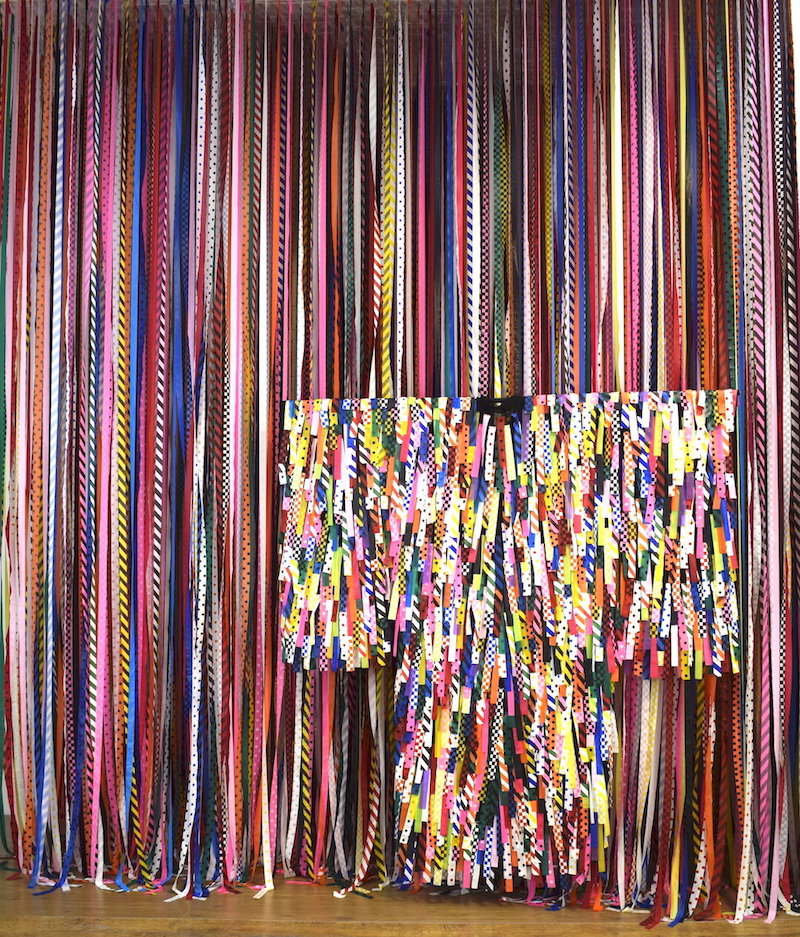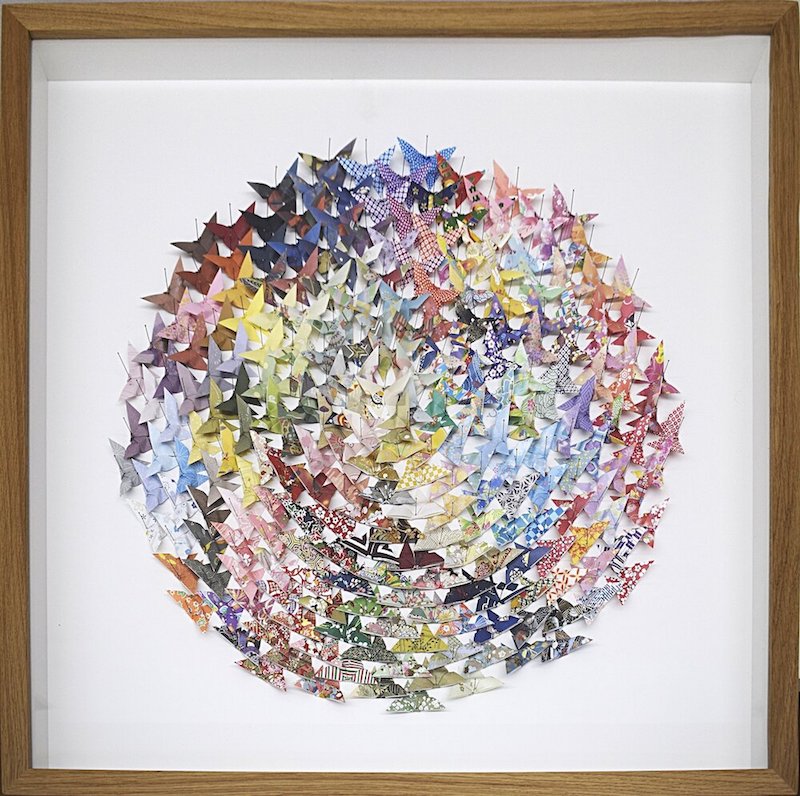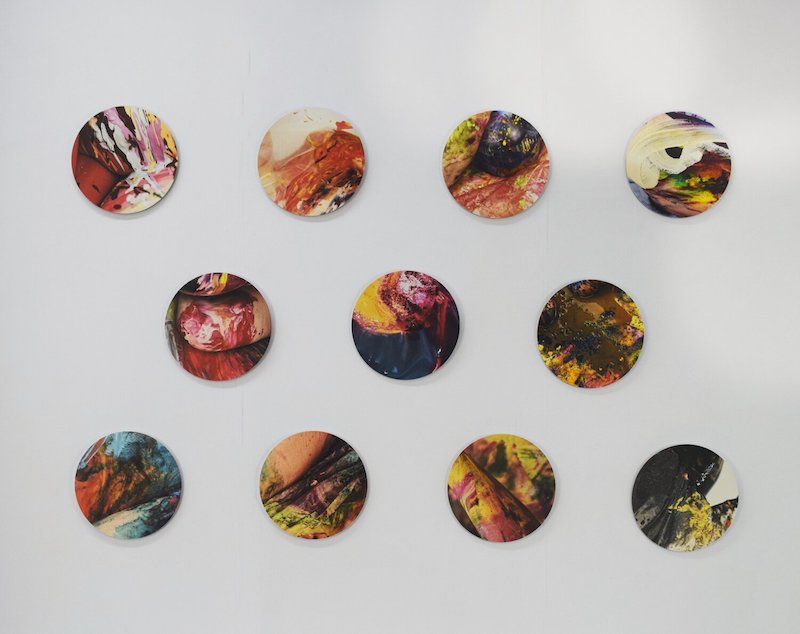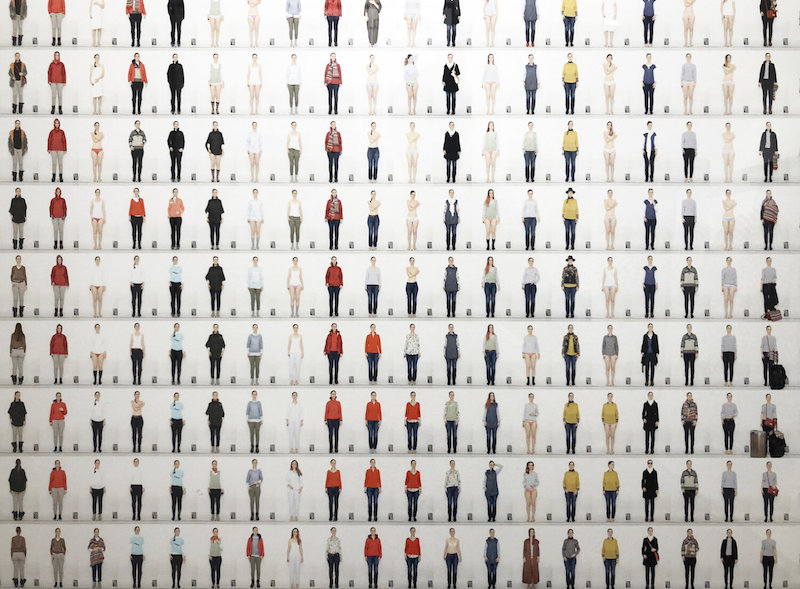by Vanessa Souli // Feb. 10, 2020
Nina Rodin’s interdisciplinary show ‘Caviar, Skin and Unsolved Systems’ at Karl Oskar Gallery in Tempelhof suggests an approach to art-making as a scientific process. With a background in neurophysiology, Rodin’s careful choice of materials and close observation of facts and data are a crucial aspect of her practice. Mathematical precision as an artistic technique and scientific data-gathering as a medium shape the foundation of her work, thus creating a profound bond between art and science. Meanwhile, concepts of painterliness and deliberation penetrate her work throughout.

Nina Rodin: ‘After the Party,’ 2020, giclee print on canvas, fabric, forestry tape, installation view, site -specific // Courtesy of the artist and Karl Oskar Gallery
Entering the gallery, visitors pass through colourful ribbons hanging overhead, which creates a pathway into the show. These ‘flagging ribbons’—normally used to mark unhealthy trees and trees for logging or for scientific analysis—serve as an introduction into the conceptual world of Rodin. The ribbons, used by humans in an attempt to control the production and development of human-made and natural forests, can be seen as a political symbol: the will to tame nature in the age of the Anthropocene. The ribbons, made of colourful plastic to stand out against the colours of the forest, are put there both as a lament to the lost woods and as an ironic comment on the replaceability of natural resources and goods in contemporary society.
Rodin’s passion for mathematical precision and scientific observation is apparent in the works presented to the left of the entrance. ‘Category of Near Infinite Permutations I-III’ consists of 215 origami butterflies, made of 1000 Japanese origami paper types collected by the artist, which form a phyllotaxic Fibonacci spiral, a mathematical distribution found in nature. In this structure, two important properties can be found: items are equally distanced from one another and the formation can develop and extend infinitely by keeping its perfectly circular arrangement.

Nina Rodin: ‘Category of Near Infinite Permutations vI – 215,’ 2018, Japanese washi paper, entomology pins 68 x 68 cm // Courtesy of the artist and Karl Oskar Gallery
The way Rodin composes and collects her data, however, comes back to the basic aspects of “painterliness” and plays with the notion of sculpture, as well. In her quest for precision and attention to detail, she brings to mind classic masters such as Bauhaus colour scientist Josef Albers, who was concerned with the subject of painterly precision and colour theory in architecture. In this example, the boundaries between sculpture, painting and natural forms are blurred and the results open up new visual experiences.
The same goes for her series of works ‘Wild Caviar I-XI,’ which draws a parallel between painting and luxury items; combined with a video one can watch through a peephole on the wall next to them, the works present close-up snapshots of paint in different colour combinations. The photos, presented in an almost voyeuristic way, as if one was looking through a microscope or keyhole, allow us to view paint as a sacred object, something difficult to acquire.

Nina Rodin: ‘Wild Caviar I-XI,’ 2019 giclée print on aluminium dibond // Courtesy of the artist and Karl Oskar Gallery
In the course of experimenting with expression through data-gathering, Rodin assigns multiple meanings to her work. In the looping video ‘The Clothes Project 01.01 – 03.02, 2017,’ we see pictures the artist took of herself as she changed outfits over the course of one year (11,985 in sum, 8 shown per second). According to Foucault, identity is not a fixed, inner feature of the human psyche but rather a flexible reality transformed and influenced by our social and cultural interactions. Although the artist intended this video to be interpreted as the cosmos of micro-decisions we face on a daily basis, according to Foucault’s theory, it is not difficult to interpret this work as a metaphor for the constantly changing identities we assume and the speed with which we adopt these identities depending on where we are and by whom we are seen. As with the flagging tape works and the paint close-ups, this work has political meaning as well; it alludes to the abundance of luxury and superfluousness of goods, which we accumulate to supplement our own well-being and the ways in which we often ignore what their manufacturing might entail for other humans and the environment.
Exhibition Info
KARL OSKAR GALLERY
Nina Rodin: ‘Caviar, Skin and Unsolved Systems’
Exhibition: Jan. 15 – Feb. 13, 2020
Burgemeister Str. 4, 12099, Berlin, click here for map

Nina Rodin: ‘The Clothes Project 01.01 – 03.02,’ 2017 Giclée print, Artist’s Proof 119 x 172 cm // Courtesy of the artist and Karl Oskar Gallery



















